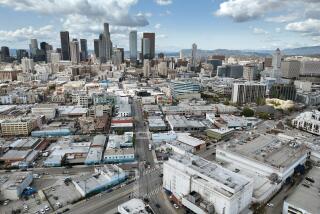Notes on a Year: Christopher Hawthorne on architecture
- Share via
If you were looking for symbolic bookends to the year in architecture, you could do worse than to start with the January opening of Dubai’s Burj Khalifa skyscraper and finish with the recent run of “In the Footprint: The Battle Over Atlantic Yards,” a musical-theater production about controversial plans to build a mammoth Frank Gehry-designed development in Brooklyn.
This was the year we began to make real sense of the fallout from the economic crisis and the boom years that preceded it. The Burj and “In the Footprint,” odd as it might sound, were in that sense two sides of the same coin, two cautionary tales about Brobdignagian urban dreams unique to the architecture of the last decade.
Opened with great fanfare on Jan. 4 as the tallest building in the world, the 2,717-foot-high Burj Khalifa, designed by Chicago architect Adrian Smith, acted instantly as a kind of 160-story Rorschach Test. For some critics it was a technical and aesthetic triumph, a productive marriage between broad-shouldered American capability and Dubai’s vast ambition. The trouble was that unlike its oil-rich neighbor Abu Dhabi — or even tiny nearby Qatar, which this month landed soccer’s 2022 World Cup — Dubai built its skyline not on petroleum reserves, of which it has few, but literally and metaphorically on sand, attempting to turn speculative growth itself into an economic engine.
The bottom, of course, ultimately fell out of that Ponzi-like strategy. When the Burj Khalifa opened it was almost entirely empty, and it has stayed that way: A report last month revealed that of its 900 condominiums, a staggering 825, or 92%, remain vacant. (Most were sold to real-estate investors who now cannot find tenants.) The Chicago Tribune’s Blair Kamin and others have pointed out that vacancy is nothing new in the history of super-tall buildings, and of course they’re right: the Empire State Building was mocked as the “Empty State Building” when it opened in 1931.
But the Burj is a different architectural animal simply because it’s unclear — even now — whether Dubai will in any of our lifetimes figure out a way to fill the massive number of high-rises, gated communities, office parks and other architectural wonders it built over the last decade. ( Manhattan in 1931 was in a deep economic trough, to be sure; but it had many decades of expansive growth in front of it.)
In a broader sense the Burj is symbolic of a particular kind of recent overbuilding driven not just by the typical cycles of real-estate-business enthusiasm but also by unprecedented access to global capital during the boom. If Dubai may never reach the size envisioned for it by its builders, couldn’t the same be said of the outskirts of Las Vegas or Phoenix? In the U.S. as in Dubai we are still digging out from under a crash for which real-estate speculation can be blamed. Even if this downturn was no Great Depression 2, its architectural fallout has a scope and character all its own.
A livelier, more political sort of fallout is the subject of “In the Footprint,” which closed Dec. 11 after a buzzed-about run in Brooklyn’s Fort Greene neighborhood. (I didn’t see the production, but its creators at a Brooklyn company called the Civilians — Steve Cosson, Jocelyn Clarke and Michael Friedman — sent me a copy of the script.) Like an Anna Deavere Smith script set to music, the show uses verbatim quotations from published interviews with public officials, neighborhood activists, developer Bruce Ratner and Gehry. Among its goals is to understand why many local residents were so deeply opposed to the proposed Atlantic Yards development, which in its hyper-ambitious original version would have added 16 towers and a staggering 8 million square feet of new construction, covering 22 acres, to a mostly midrise landscape near downtown Brooklyn. After the credit crunch hit the project was significantly downsized and Gehry was fired by Ratner; the only portion going forward is an arena designed by a young New York firm called SHoP. The Civilians’ treatment of the story does the work of cultural historians with unexpected flair and an effectively light touch, as when one resident says of the SHoP design, which to put it kindly was produced rather hurriedly, “Some people think it looks like the George Foreman Grill.” Now that you mention it, that’s not too far off.
There is no question that the development was overscaled, but Gehry’s enthusiasm for it gave the project momentum and at least a sheen of cultural legitimacy. Indeed, the contrast between its elephantine mass and some nimble architectural moments — particularly in Gehry’s innovative initial design for the arena — made it difficult for me to easily pigeonhole. For many locals, on the other hand, it represented a takeover of their streets by outside interests, a new brand of urban renewal hiding beneath celebrity architecture’s endlessly diverting cloak.
More to Read
The biggest entertainment stories
Get our big stories about Hollywood, film, television, music, arts, culture and more right in your inbox as soon as they publish.
You may occasionally receive promotional content from the Los Angeles Times.











